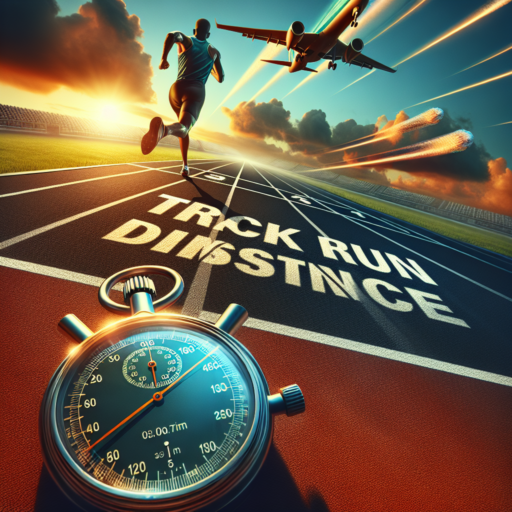How to Accurately Track Your Running Distance
Tracking your running distance accurately is crucial for any runner, whether you’re a beginner aiming to improve your fitness or a seasoned marathoner fine-tuning your training. The evolution of technology has brought forward various methods to ensure that every step counts. In this discussion, we delve into how to leverage these tools and techniques to enhance your running experience.
Utilize GPS Running Watches
One of the most accurate ways to track your running distance is through GPS-enabled running watches. These devices offer precision by using satellites to track your movement. Brands like Garmin, Suunto, and Polar provide a range of options that cater to different needs and budgets. Not only do they record your distance, but they also analyze your pace, cadence, and even your route, offering a comprehensive overview of your performance.
Explore Smartphone Running Apps
For runners who prefer not to invest in a dedicated watch, smartphone running apps present an alternative. Applications such as Strava, Runkeeper, and Nike Running Club use your phone’s GPS to track your distance accurately. These apps not only measure your run but also offer virtual coaching, community support, and challenges to keep you motivated. It’s important to ensure your phone’s GPS is calibrated correctly for the most accurate readings.
Whether you choose a high-tech GPS watch or a versatile smartphone app, the key is consistency. Using the same method for tracking your runs allows you to accurately measure your progress over time. Incorporating these tools into your training can help you reach your running goals with precision and confidence.
Top Apps for Tracking Your Run Distance in 2023
As the world of fitness continues to evolve, runners, from novices to marathon veterans, are always on the lookout for the best tools to enhance their training experience. 2023 has brought a plethora of apps designed to meticulously track your running distance, offering a blend of features that cater not only to tracking but also to improving your overall running efficiency. In this digital age, choosing the right app can significantly impact your running goals and outcomes.
Among the array of options available, a few apps have stood out for their accuracy, reliability, and user-friendly interfaces. These applications use GPS technology to offer real-time data, detailed analytics, and personalized coaching tips. Additionally, features such as social sharing, integrated music playlists, and tailored training plans have become indispensable for runners seeking a comprehensive and immersive training tool. Taking a closer look at the top contenders can give us a clearer picture of what each app has to offer.
First on the list is Strava, renowned for its extensive community features that allow runners to connect and compete with each other. Strava not only tracks your run distance but also segments your route, enabling users to see how they perform on specific portions of their runs compared to other runners. Next, we have Runkeeper, an app appreciated for its versatility and adaptability to runners of all levels. Whether you’re just starting out or are a seasoned marathoner, Runkeeper provides detailed metrics and customizable training plans to meet your specific needs. Lastly, Nike Run Club offers a unique blend of motivational tools and coaching advice, making it an excellent companion for those looking to push their limits and achieve personal bests.
The decision on which app to choose ultimately depends on your personal running goals, the type of data you find most useful, and whether you’re looking for a community of runners to join. Each of these apps brings something unique to the table, ensuring that there’s something out there for every type of runner. As we continue through 2023, staying informed and experimenting with different apps can significantly enhance your running experience.
Certainly! Focusing on the SEO aspect for the topic «Benefits of Tracking Your Running Distance», let’s dive into the content creation.
Benefits of Tracking Your Running Distance
Tracking your running distance is more than a measure of how far you’ve gone; it’s a gateway to in-depth insights into your physical health and performance. By understanding your running patterns, you can unlock potential improvements in endurance and speed, tailor your goals more precisely, and monitor your progress over time. The digital age has made tracking easier and more accurate, offering runners the ability to view their achievements in real-time and adjust their training accordingly.
Enhanced Motivation and Goal Setting
One of the key benefits of monitoring your running distance is the motivational boost it provides. Seeing tangible evidence of your progress acts as a powerful incentive to keep going. Setting goals becomes a more reasoned process when you have data at your fingertips. It allows for setting specific, measurable objectives, which is a cornerstone of effective training. Whether it’s increasing your weekly mileage or targeting a specific race distance, tracking aids in bridging the gap between where you are and where you want to be.
Optimizing Training and Recovery
Accurately tracking your runs can help in fine-tuning your training regime. By analyzing distance over time alongside other metrics like pace and heart rate, runners can identify patterns and adjust their training intensity, duration, and frequency to maximize performance while minimizing injury risk. This data-driven approach ensures that you’re not overtraining or undertraining, promoting a healthier balance between exertion and recovery. Smart tracking can inform when to push your limits and when to ease back, crucial for long-term development and avoiding burnout.
Setting Realistic Goals with Run Distance Tracking
Establishing achievable milestones in your running journey is pivotal to maintaining motivation and watching your progress flourish. With the utilization of run distance tracking technology, athletes and hobbyists alike can set informed and realistic goals that align with their physical capacities and ambitions. This modern approach to monitoring your runs helps in outlining a structured plan, ensuring your targets are not only ambitious but also within reach.
How Run Distance Tracking Influences Goal Setting
Run distance tracking tools equip runners with detailed insights about their activities, enabling a more nuanced understanding of performance over time. By analyzing trends in your distance coverage, you can incrementally increase your goals in a manner that is both challenging and achievable. This data-driven strategy ensures every goal set is backed by personal performance metrics, making the journey towards improvement both measurable and motivating.
Moreover, incorporating run distance tracking into your routine encourages a holistic view of progress. Rather than focusing solely on speed or calories burnt, you can celebrate advancements in distance, endurance, and consistency. Each increment in distance achieved can be a stepping stone towards larger objectives, providing a sense of accomplishment while pushing your limits responsibly. By understanding your current capabilities and how they evolve, your running goals can evolve in tandem, fostering a sustainable and rewarding running practice.
Understanding the Features of a Good Run Tracking App
Identifying a good run tracking app can significantly impact your fitness journey, especially if running is your exercise of choice. These apps not only monitor your progress but also motivate you to push your boundaries. Key features differentiate an ordinary run tracking app from an exceptional one. Understanding these features will help you choose the app that best suits your fitness goals.
Accurate Distance and Time Tracking
Accuracy in distance and time tracking stands as the backbone of any quality run tracking app. Whether you’re a casual jogger or a marathon runner, seeing precise measurements of how far and how long you’ve run can greatly influence your motivation and progress assessment. GPS functionality is central to ensuring this accuracy, providing real-time updates on your location and movement.
Custom Training Plans
An ideal run tracking app goes beyond just monitoring; it acts as your personal coach. Customizable training plans tailored to your specific goals, whether it’s running a certain distance, reaching a target weight, or preparing for a race, elevate a run tracking app from good to great. Such personalization ensures that the app adapitates to your evolving fitness level and objectives.
Integration with Other Health Apps and Devices
To holistically assess your fitness, a premium run tracking app should offer seamless integration with other health apps and devices. This compatibility allows for comprehensive health data collection, from calorie intake to sleep patterns, providing a well-rounded picture of your overall wellbeing. The ability to sync this data across multiple platforms ensures you have access to a unified health dashboard, no matter where you are.
How to Improve Your Running Performance by Tracking Distance
Improving your running performance involves a multifaceted approach and tracking the distance you run is an essential piece of this puzzle. By systematically noting the lengths of your runs, you gain insights into your progress, understand your capabilities, and can set tangible, achievable goals. The data collected from tracking your runs enables you to make informed decisions about how to adjust your training regimen for optimal performance.
Establishing a Baseline and Setting Goals
The first step in leveraging your running distance for performance improvement is to establish a baseline. This means consistently recording your runs over a period to understand your average distance. Once a baseline is established, setting incremental goals becomes possible. For example, if your average run is 5 kilometers, you might set a goal to increase this distance by 10% in the next month. The key is to set realistic, measurable goals that motivate you to push your limits while avoiding injury.
Utilize Technology for Accurate Tracking
In today’s digital age, a myriad of tools and apps are available to help runners accurately track their distance. Utilizing devices such as GPS watches or smartphone apps that specialize in running can provide precise measurements and offer insights into each run’s specifics, such as pace, elevation gain, and more. By having access to detailed data, you can analyze your performance over time, identify patterns or areas for improvement, and adjust your training accordingly.
Understanding the correlation between the distance run and improvements in running performance can ignite a cycle of motivation and achievement. By focusing on both quantity and qualityCombining Pace and Distance for Improved Running Training
Integrating both pace and distance into your running training can significantly boost your performance and endurance. Understanding how these two elements work together will empower you to tailor a more effective workout regimen. The key is to strike a balance that stimulates your body’s adaptations without leading to exhaustion or injury.
Benefits of Pace and Distance Combination
The primary advantage of combining these aspects is it prepares runners for a variety of conditions and goals. Focusing on distance improves endurance and teaches the body to efficiently use its energy over longer periods. On the other hand, pace training enhances speed, strengthens the cardiovascular system, and increases lactate threshold. When merged appropriately, runners can achieve remarkable versatility and resilience, crucial for tackling races of any length or engaging in recreational running more enjoyably.
Another crucial aspect to consider is the psychological benefit. Alternating between different types of training sessions keeps the routine fresh and mentally stimulating. It helps evade the boredom that often comes with repetitive training, boosting overall motivation and the likelihood of adhering to a training plan.
Creating a Balanced Training Plan
Developing a training plan that encompasses both pace and distance elements requires careful consideration of your current fitness level, goals, and schedule flexibility. Initially, start with a focus on building a base distance, gradually increasing the length of your runs over weeks. Once a solid endurance foundation is established, incorporate pace workouts, such as intervals or tempo runs, to start enhancing your speed. The integration of these training types should be methodically planned to allow for sufficient recovery, ensuring improvements without overtraining.
Troubleshooting Common Issues with Run Distance Tracking Devices
Having accurate data is crucial for runners who rely on distance tracking devices to monitor their progress and performance. Yet, occasionally, these gadgets may present issues that can skew the data or, worse, halt tracking altogether. Identifying and troubleshooting these common problems can help ensure that your training sessions are recorded with precision.
Ensuring GPS Accuracy
One of the primary reasons for discrepancies in run distance data is the GPS accuracy of your device. Devices can sometimes struggle with capturing a stable GPS signal, especially in areas with dense tree cover or tall buildings. To enhance GPS accuracy, ensure your device has a clear view of the sky before starting your run. It’s also beneficial to regularly update your device’s firmware, as manufacturers often release updates that improve GPS functionality. If you’re experiencing consistent issues, consider resetting your GPS data or, if possible, recalibrating your device.
Device Firmware Updates
Outdated firmware can lead to a host of issues, including inaccurate distance tracking. Manufacturers frequently release updates that not only fix bugs but also improve overall device performance. Checking for firmware updates regularly ensures that your device operates with the latest improvements. This can typically be done through the device’s companion app or, in some cases, directly through the device’s settings. Ignoring firmware updates can leave your device functioning suboptimally, affecting the accuracy of your run data.
’ relatedtext=’Quizás también te interese:’]
Interference and Multi-Sport Transitions
Electromagnetic interference from high-voltage power lines or large metal objects can also affect GPS accuracy. If your usual running route passes close to such sources, consider altering your route slightly to avoid them. Additionally, for athletes who use their distance tracking devices across multiple sports (e.g., triathletes), transitioning between sports modes can sometimes introduce errors. Ensure you’re fully familiar with how your device handles these transitions and make any necessary adjustments to settings before embarking on training sessions that include multiple disciplines.
No se han encontrado productos.
Comparing Wearables: Which Are Best for Distance Tracking?
When it comes to finding the best wearables for distance tracking, the competition is stiff. Consumers often look for devices that not only offer precise tracking capabilities but also integrate seamlessly with their lifestyles. With a myriad of options available in the market from brands like Fitbit, Garmin, and Apple, pinpointing the one that aligns with your requirements necessitates a deep dive into their functionalities and user experiences.
Accuracy is paramount for distance tracking wearables. Devices such as the Garmin Forerunner series and Apple Watch stand out for their GPS precision. These high-end trackers use advanced satellite navigation systems to accurately record your movements, making them ideal for runners, cyclists, and outdoor enthusiasts. However, the choice between them often boils down to the ecosystem you’re already a part of – with Apple products typically integrating better with other Apple devices.
Battery life is another critical factor to consider. Extended battery duration is vital for long sessions of activity or when you’re unable to charge the device daily. In this segment, watches like the Fitbit Charge excel, offering up to seven days of battery life on a single charge. This makes them perfect for tracking your weekly distances without the hassle of frequent recharging.
The Future of Run Distance Tracking: Trends and Technologies
The realm of run distance tracking is on the brink of transformative changes, propelled by cutting-edge technologies and emerging trends. As we delve deeper into the future landscape of this exciting domain, several key trends and advancements stand out, poised to redefine how runners measure, interpret, and optimize their performances.
Innovative Wearable Tech
Wearable technology is at the forefront of revolutionizing run distance tracking. The next generation of wearable devices goes beyond basic step counting to offer in-depth analytics, such as stride length, cadence, and even advanced biomechanical feedback. This evolution enables runners to gain unprecedented insights into their running mechanics, fostering improved performance and injury prevention.
Integration with Augmented Reality (AR)
Augmented Reality (AR) is set to bring an immersive twist to run distance tracking. By overlaying virtual elements onto the real world, runners could navigate virtual courses, compete with digital avatars, or follow complex training programs with ease. This technology promises not just to enhance the training experience but also to make it more engaging and enjoyable, thereby encouraging consistent practice and improvement.
The convergence of these trends and technologies heralds a future where run distance tracking transcends mere measurement. It’s evolving into a comprehensive ecosystem that offers enriched data analytics, personalized training insights, and interactive running experiences. As we move forward, the integration of AI, machine learning, and community-driven features are expected to further enrich this landscape, making run distance tracking an indispensable tool for runners worldwide.




